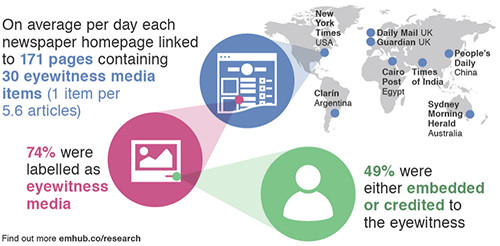New study cites unethical practices by some media

A research study has found emerging evidence that photographs and videos featured in online newspaper articles are often presented inaccurately or used without permission. The research exposed evidence that some eyewitnesses had experienced great distress due to unethical practices by certain publications.
Researcher Pete Brown, Ph.D., from Eyewitness Media Hub, studied the websites of eight newspapers from around the world, and discovered significant differences in how each one utilizes photos and videos captured by people on their digital cameras and mobile devices.
The research, titled "A Global Study of Eyewitness Media in Online Newspaper Sites," is a follow up to a recent study that Brown co-authored with Claire Wardle and Sam Dubberley for the Tow Center for the Study of Digital Journalism, which explored how this kind of footage is handled by television broadcasters. Using the same methodology as the original study, Brown set out to better understand how some of the most popular online newspaper sites incorporate eyewitness media into their output.
The study found that eyewitness media is used by all eight newspaper websites to report an extraordinarily broad range of stories. It also found that the most popular western news sites feature substantially more eyewitness media than their global counterparts.
Here are some more of the most note-worthy findings:
- In some cases eyewitness videos were the sole subject of a story, with screenshots and text descriptions used to pad out entire articles.
- In the cases where screenshots were used, some featured graphic or upsetting imagery without warning or pixilation.
- Attribution was inconsistent and confused, with social platforms regularly credited for a photo or video instead of the name of the content owner.
- Content sourced from social platforms was sometimes used without permission being sought or granted.
- In some cases where permission was not sought or granted, the owner was credited by name causing anxiety, embarrassment or exposure to abuse.
Brown studied 27,802 stories in total, published on eight news sites over 21 consecutive days. The sites analysed for this study were selected based on their popularity. They were the New York Times, the Guardian, the Daily Mail, the Cairo Post, the People's Daily (from China), the Sydney Morning Herald, the Clarín (from Argentina) and the Times of India.
"For all the discussion about 'citizen journalism', UGC, 'amateur footage' and other common terms, there are few studies that provide evidence of how much of this eyewitness media is actually being used by the 'mainstream' news," said Pete Brown. He added: "This piece of research gives us more compelling evidence that not only is it an integral part of both soft and hard news coverage, but more must be done to raise awareness around the rights of and responsibilities towards eyewitnesses. "
Eyewitness Media Hub's criteria for analyzing this research was to identify any visual content captured by a person who is not related to a newsroom. This meant that photographs and videos by extremists groups like ISIS were also included. The study reveals that 24 percent of all content analyzed was sourced from ISIS social media channels, which demonstrates a significant reliance and willingness by online newspaper sites to use such footage and highlights another important area for consideration in terms of how it is verified and labeled.
The research is being published online at emhub.co/research. Key findings from the study are presented alongside short, shareable explainer videos and graphic visualizations of the data in an effort to reach a broad audience of industry practitioners.
Jenni Sargent from Eyewitness Media Hub will host a training webinar as part of the MediaShift DigitalEd series to raise awareness of the research recommendations and highlight best practice techniques for handling eyewitness media. The webinar will take place on Friday, May 22, 1 p.m. (EDT). More details can be found here.
The digital publication and distribution of this research is supported by the College of Journalism and Communications at the University of Florida, the Hugh Cunningham Professorship in Journalism Excellence and the John S. and James. L. Knight Foundation.
Eyewitness Media Hub was established in July 2014 to support the creation, discovery, verification and publication of eyewitness media. This research was undertaken using seed investment donated by Storyful.





